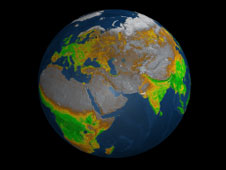Article and Image Courtesy: NASA
A new NASA computer modeling effort has found that additional growth of plants and trees in a world with doubled atmospheric carbon dioxide levels would create a new negative feedback – a cooling effect – in the Earth's climate system that could work to reduce future global warming.
 A new NASA modeling effort found that in a doubled-carbon dioxide world plant growth could lessen global warming by about 0.3 degrees C globally. The same model found that the world would warm by 1.94 degrees C without this cooling feedback factored in. Image: Great Smoky Mountains National Park; Credit: National Park Service
A new NASA modeling effort found that in a doubled-carbon dioxide world plant growth could lessen global warming by about 0.3 degrees C globally. The same model found that the world would warm by 1.94 degrees C without this cooling feedback factored in. Image: Great Smoky Mountains National Park; Credit: National Park Service
The cooling effect would be -0.3 degrees Celsius (C) (-0.5 Fahrenheit (F)) globally and -0.6 degrees C (-1.1 F) over land, compared to simulations where the feedback was not included, said Lahouari Bounoua, of Goddard Space Flight Center, Greenbelt, Md. Bounoua is lead author on a paper detailing the results that will be published Dec. 7 in the journal Geophysical Research Letters.
Without the negative feedback included, the model found a warming of 1.94 degrees C globally when carbon dioxide was doubled.
Bounoua stressed that while the model's results showed a negative feedback, it is not a strong enough response to alter the global warming trend that is expected. In fact, the present work is an example of how, over time, scientists will create more sophisticated models that will chip away at the uncertainty range of climate change and allow more accurate projections of future climate.
"This feedback slows but does not alleviate the projected warming," Bounoua said.
To date, only some models that predict how the planet would respond to a doubling of carbon dioxide have allowed for vegetation to grow as a response to higher carbon dioxide levels and associated increases in temperatures and precipitation.
Of those that have attempted to model this feedback, this new effort differs in that it incorporates a specific response in plants to higher atmospheric carbon dioxide levels. When there is more carbon dioxide available, plants are able to use less water yet maintain previous levels of photosynthesis. The process is called "down-regulation." This more efficient use of water and nutrients has been observed in experimental studies and can ultimately lead to increased leaf growth. The ability to increase leaf growth due to changes in photosynthetic activity was also included in the model. The authors postulate that the greater leaf growth would increase evapotranspiration on a global scale and create an additional cooling effect.
 This animation shows seasonal vegetation changes on Earth in 2004, created using NASA satellite data. It is an animation of what is called the Normalized Vegetation Difference Index, which provides an indication of the health of plant life on Earth. Source: Scientific Visualization Studio, Goddard Space Flight Center
This animation shows seasonal vegetation changes on Earth in 2004, created using NASA satellite data. It is an animation of what is called the Normalized Vegetation Difference Index, which provides an indication of the health of plant life on Earth. Source: Scientific Visualization Studio, Goddard Space Flight Center
"This is what is completely new," said Bounoua, referring to the incorporation of down-regulation and changed leaf growth into the model. "What we did is improve plants' physiological response in the model by including down-regulation. The end result is a stronger feedback than previously thought."
The modeling approach also investigated how stimulation of plant growth in a world with doubled carbon dioxide levels would be fueled by warmer temperatures, increased precipitation in some regions and plants' more efficient use of water due to carbon dioxide being more readily available in the atmosphere. Previous climate models have included these aspects but not down-regulation. The models without down-regulation projected little to no cooling from vegetative growth.
Click here to read the entire article





 Greener_Climate_Prediction_Shows_Plants_Slow_Warming.pdf
Greener_Climate_Prediction_Shows_Plants_Slow_Warming.pdf







